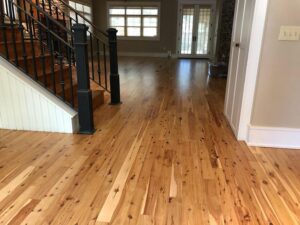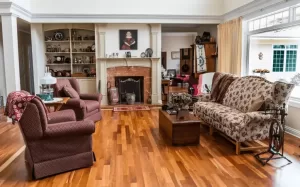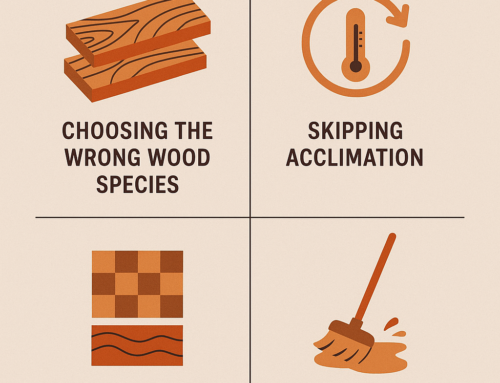Hardwood Floor Installation: The Essential Steps

Installing hardwood floors in your home can significantly enhance its aesthetic appeal while adding value. However, this task requires careful planning, precise execution, and attention to detail. Whether you’re a seasoned DIYer or a novice, understanding the essential steps for a successful hardwood floor installation is crucial. This guide outlines the key phases and offers expert advice and flooring tips to ensure a smooth and successful installation process from start to finish.
Preparing the Subfloor
Preparing the subfloor before laying your new hardwood floors is critical to ensuring their longevity and stability. The subfloor is the foundation upon which your hardwood will rest, so taking the time to prepare it can save you from future headaches properly.
Removing old flooring
The first step in preparing the subfloor is to remove any existing flooring. This might include carpet, tile, laminate, or even old hardwood. It’s important to remove this flooring carefully to avoid damaging the subfloor beneath. If you’re dealing with carpet, start by cutting it into strips and pulling it up along with the padding beneath. For tile and laminate, you may need to use a pry bar and hammer to gently lift and remove the pieces. Once the old flooring is removed, clean the subfloor thoroughly to remove any debris, dust, or adhesive residue.
Ensuring a level surface
Once the old flooring is removed and the area is clean, the next step is to check for levelness. A level subfloor is crucial for a successful hardwood floor installation. Use a long level or straightedge to identify any high or low spots in the subfloor. Low spots can be filled with a self-leveling compound, while high spots may need to be sanded down. It’s also essential to fix any squeaks or loose areas in the subfloor by screwing down the loose parts to the floor joists. Ensuring a level surface helps prevent future issues such as creaking, uneven flooring, or even damage to the hardwood.
Acclimating the Hardwood
Hardwood flooring needs to adjust to its new environment’s temperature and humidity levels before installation. This process, known as acclimation, helps minimize expansion and contraction after installing the floors.
Unpacking and storing the flooring
Begin the acclimation process by unpacking the hardwood planks and removing any plastic wrap. This allows the wood to breathe and begin adjusting to the indoor climate. Store the planks in the room where they will be installed, laying them flat and spreading them out if possible. Avoid storing the flooring in a location with a significantly different climate, such as a damp basement or an unheated garage.
Allowing the hardwood to adjust to the environment
The length of time needed for acclimation can vary based on geographic location, time of year, and the specific type of hardwood. Typically, allowing the wood to acclimate for 3 to 5 days is recommended, but some situations may require a week or more. During this time, maintain a consistent temperature and humidity level in the room to help the wood adjust. Skipping or rushing this step can lead to warping, buckling, or gaps in the floor as the seasons change, so patience here is key to ensuring a successful hardwood floor installation.
Installing the Underlayment
Before laying down the hardwood, a crucial step is to install the underlayment. This layer provides a smooth, level base, reduces noise, and adds a bit of cushioning, enhancing the longevity of your hardwood floors.
Choosing the right underlayment material
When selecting an underlayment material, consider factors such as the type of subfloor you have (concrete or wood), the need for moisture protection, and sound-dampening properties. Common materials include foam, cork, felt, and rubber. Each has its advantages, with foam being lightweight and affordable, cork offering natural resistance to mold and mildew, felt adding superior sound absorption, and rubber providing excellent moisture barrier and durability.
Installing underlayment properly
Preparation: Ensure the subfloor is clean, dry, and level. Any irregularities might affect the final appearance and functionality of the hardwood floors.
Rolling Out: Roll the underlayment in the same direction as you plan to lay the hardwood boards. This ensures consistency and ease during the actual flooring installation. - Cutting to Fit: Use a utility knife to cut the underlayment to fit the rooms dimensions accurately. Pay attention to doorways and other irregular shapes.
Seaming: If your underlayment comes in rolls or strips, make sure the seams are tightly butted together without overlapping. Use manufacturer- recommended tape to secure the seams and prevent shifting.
Measuring and Marking the Layout
Achieving a visually appealing and properly fitting hardwood floor starts with careful measuring and marking of the layout before any installation begins.
Determining the starting point and direction of the boards
Deciding where and how to start laying your hardwood floors is pivotal. Consider starting from the longest, most visible wall or running the boards perpendicular to the floor joists for added stability. Remember, natural light source and room layout can significantly affect the appearance of your hardwood floors, so plan the direction of your boards accordingly.
Marking the layout for a proper fit
Measurement: Measure the rooms length and width to determine the number of boards needed and to plan for any necessary cuts at the rooms borders.
Expansion Gap: Allow for an expansion gap around the rooms perimeter. This gap, usually about a quarter of an inch, accommodates the natural expansion and contraction of the wood. - Chalk Lines: Use a chalk line tool to mark your starting point based on your measurements. These lines serve as a guideline to ensure your boards are laid straight and evenly across the room. -
Dry Layout: It’s beneficial to lay out a few rows of boards without fastening them to get a visual of how the floor will look and to make any adjustments to your layout plan before the actual installation. Following these essential steps ensures a successful hardwood floor installation,
providing a beautiful and durable addition to your home.
Cutting and Fitting the Hardwood
One pivotal step in hardwood floor installation is cutting and fitting the planks. This process not only sets the stage for how seamlessly the floor will come together but also affects its overall durability and appearance.
Selecting the right cutting tools
Choosing the right tools for cutting hardwood is crucial for both your projects efficiency and the results quality. A miter saw is ideal for making crosscuts on boards, ensuring the planks fit perfectly at the rooms edges. A table saw is preferred for lengthwise cuts or rip cuts. A jigsaw might be handy for intricate cuts, like around corners, or for custom shapes. Ensuring that your cutting tools are sharp and specifically designed for hardwood is key to preventing splintering and ensuring smooth cuts.
Measuring and cutting the boards accurately
Accuracy in measuring and cutting cannot be overstated. Before making any cuts, please always measure the area where the plank will be placed, considering any expansion gaps. These gaps are vital for natural wood expansion and can prevent buckling. Double-check measurements before cutting to minimize waste and ensure each piece fits perfectly in its designated space.
Fitting the boards together snugly
Once the boards are cut to the right size, fitting them snugly together is essential for a seamless look and to enhance the floors stability. Many modern hardwood floors come with a tongue-and-groove system that facilitates interlocking, helping to create a smooth, uniform surface. During this phase, paying close attention to the pattern and grain direction can significantly impact the floors final appearance. It’s also important to mix planks from different boxes to ensure a varied and natural look.
Nailing or Stapling the Boards
After cutting and fitting the hardwood planks, securing them to the subfloor is the next crucial step. This can be achieved through nailing or stapling, depending on the type of hardwood and the installers preferences.
Choosing the appropriate fastening method
The choice between nailing and stapling often depends on the hardwoods thickness and the subfloor type. Nails are preferred for most solid hardwood floors because they provide stronger holding power. Engineered hardwood, being thinner, can be stapled down. Regardless of the method, using a flooring nailer or stapler can make the job easier and more efficient
Properly attaching the boards to the subfloor
Securing the boards properly to the subfloor is crucial for preventing movement and squeaking. When nailing, it’s important to place nails at angled intervals along the tongue of the boards, which allows for natural wood expansion and hides nail heads for a cleaner look. Ensure that the fasteners are not too close to the edge to avoid splitting the wood. The goal is a firm attachment to the subfloor without hindering the woods natural expansion and contraction.
Dealing with Obstacles
Hardwood floor installation presents challenges, not least the obstacles presented by doorways, vents, and other fixed features within a room. Each obstacle requires a unique strategy to ensure the installation is seamless and aesthetically pleasing.
Addressing doorways, vents, and other obstacles
When dealing with doorways, it is crucial to trim the bottom of the door frames to allow the hardwood planks to slide underneath, ensuring a continuous flow. Careful measurements must be taken for vents to cut the hardwood planks precisely, allowing the vent covers to sit flush against the floor without obstructing airflow. This meticulous attention to detail enhances the rooms functionality and contributes to the overall aesthetics.
Making necessary adjustments for a seamless look
In some cases, obstacles may require slight deviations from the original layout plan. For example, you might need to adjust the direction or pattern of the planks to effectively navigate around a fixed obstacle. In these instances, it is important to maintain the alignment of the planks as much as possible. Transitions between hardwood floors and other types of flooring should be handled with transition strips designed to create a cohesive look while accommodating the different materials.
Finishing touches
Once the hardwood planks are securely in place, the focus shifts to the finishing touches that will define the look and longevity of the flooring.
Filling gaps and cracks
Even with precise installation, small gaps and cracks can appear between the planks or at the edges of the room. Filling these gaps with a color-matched wood filler can help achieve a smooth, uniform surface and prevent dirt and moisture from infiltrating the flooring, which could lead to damage over time.
Sanding the floor for a smooth finish
Sanding is a critical step in preparing the floor for finishing. From coarse sandpaper to finer grits, sanding removes any unevenness, smooths out filled gaps, and prepares the wood to accept the finish evenly. Proper sanding is key to avoiding a patchy or uneven appearance.
Applying an appropriate finish
Choosing the right finish for your hardwood floors depends on the level of durability you require and the aesthetic you wish to achieve. Options range from polyurethane, which offers high protection and is available in matte, satin, and gloss finishes, to natural oils, which penetrate the wood to enhance its innate beauty. Applying the chosen finish meticulously, according to the manufacturers instructions, will safeguard your floors and highlight their natural elegance, completing your successful hardwood floor installation.
Cleaning and Maintenance
Ensuring your newly installed hardwood floors stay pristine involves consistent cleaning and regular maintenance. Adhering to these steps preserves the floors appearance and extends its lifespan.
Properly cleaning the newly installed floor
After installation, it’s vital to remove any dust or debris left behind. Use a soft-bristled broom or a vacuum designed for hardwood floors to clean the surfacegently. Avoid using water or liquid cleaners directly on the floor, as excessivemoisture can damage wood. For stubborn spots or scuffs, opt for a manufacturer-recommended hardwood floor cleaner applied to a microfiber cloth or mop. This method ensures a thorough cleaning without risking water damage.
Regular maintenance tips for longevity
– Place rugs or mats at entrances to minimize the amount of dirt and grit that can scratch the floor.
– Use felt pads under furniture legs to prevent scratches when moving items.
– Keep pets’ nails trimmed to avoid scratches. - Maintain a stable indoor humidity level (between 35% and 55%) to prevent the wood from expanding or contracting.
– Avoid walking on the floors with high heels or heavyboots.
Conclusion
In conclusion, while the idea of tackling a DIY hardwood floor installation may be tempting, it’s a complex task that requires precision and expertise. At Troendle Hardwood Floors, our skilled team excels in delivering professional results. Avoid the risks of mistakes or inferior outcomes – trust us to bring your hardwood floor vision to life with our craftsmanship and attention to detail. Contact us today to schedule your consultation and start your journey toward beautiful hardwood floors.






